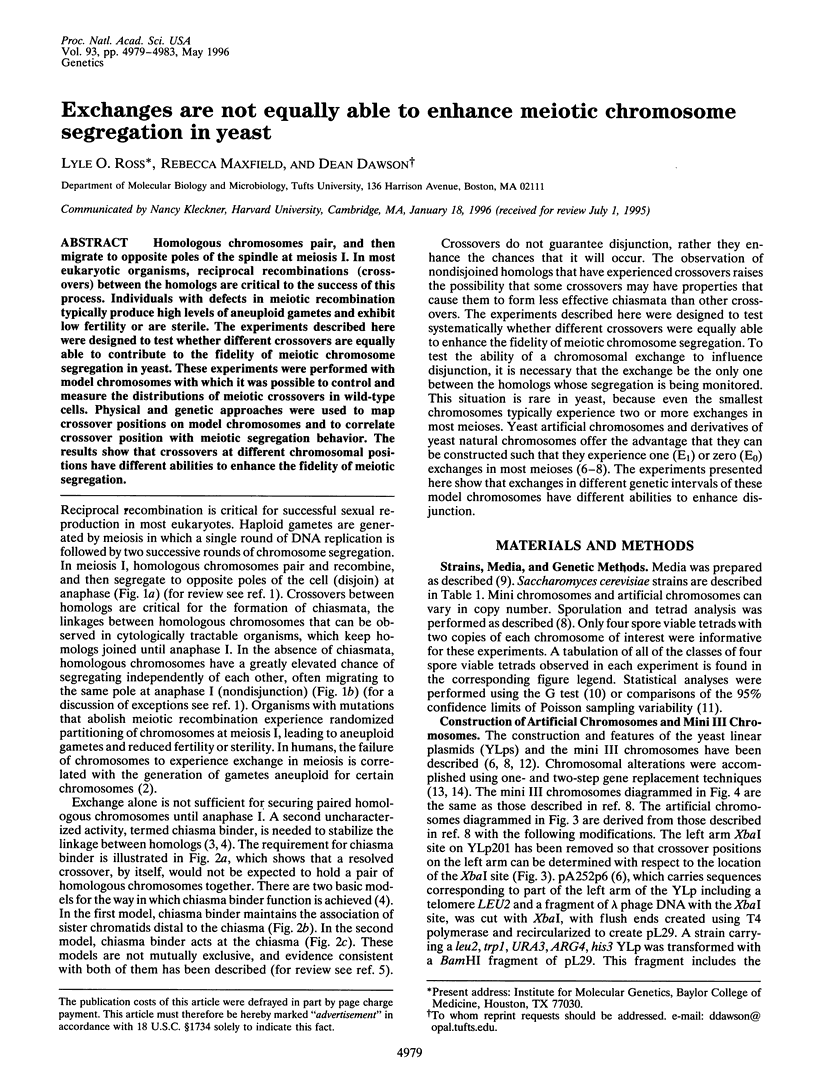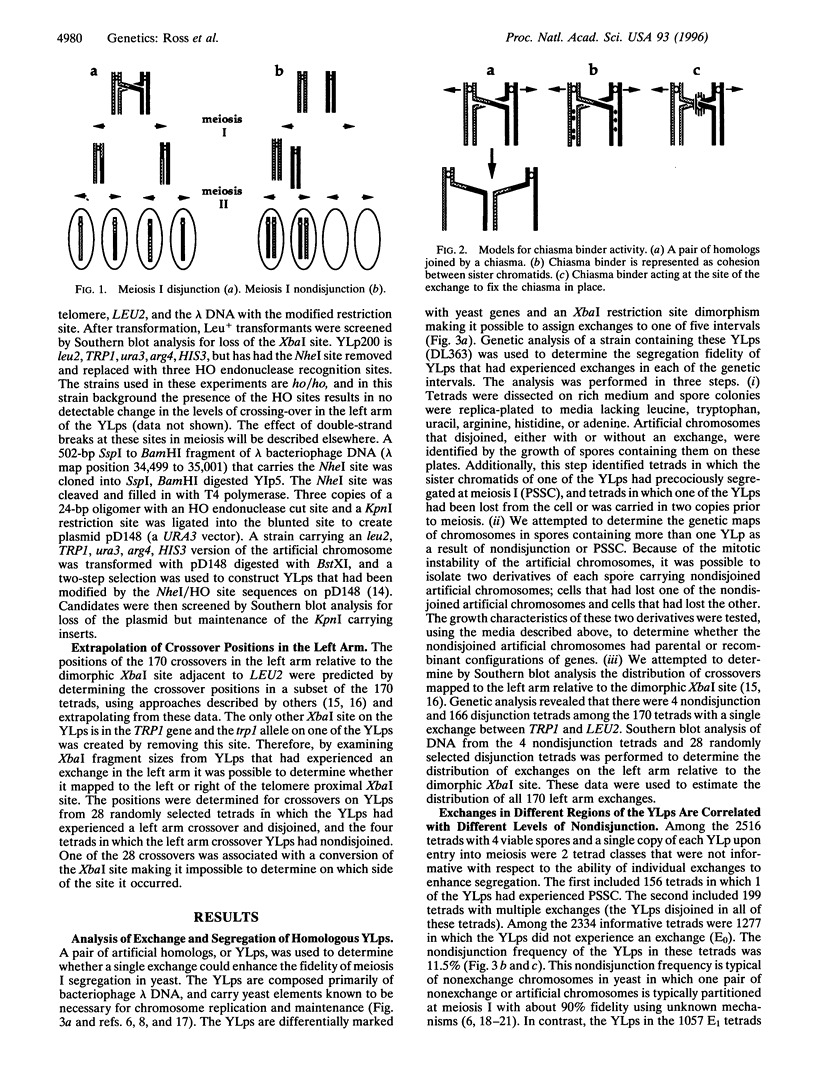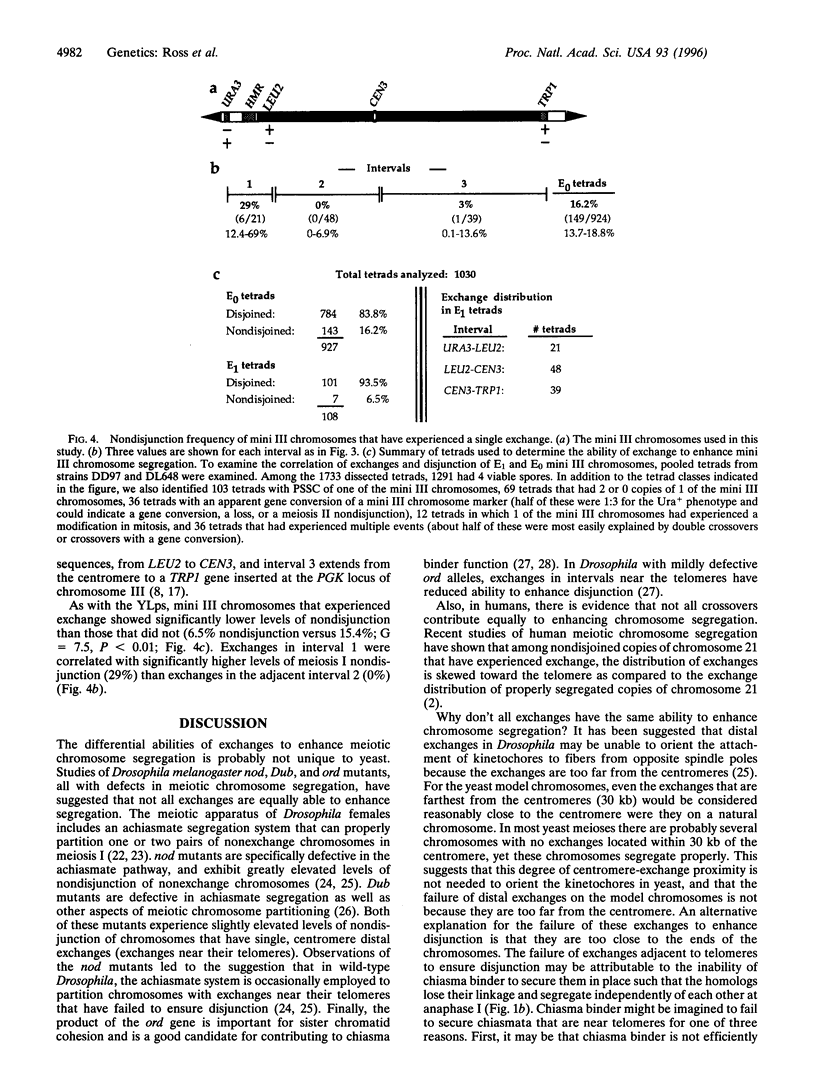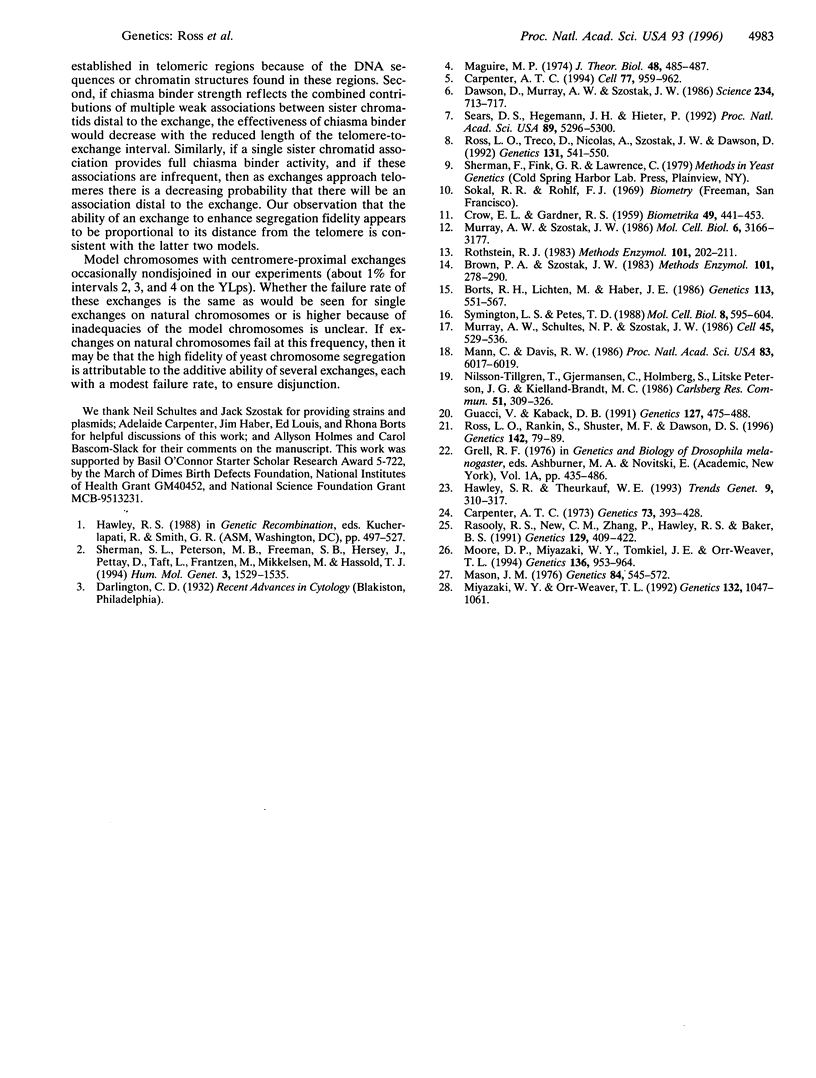Abstract
Homologous chromosomes pair, and then migrate to opposite poles of the spindle at meiosis I. In most eukaryotic organisms, reciprocal recombinations (crossovers) between the homologs are critical to the success of this process. Individuals with defects in meiotic recombination typically produce high levels of aneuploid gametes and exhibit low fertility or are sterile. The experiments described here were designed to test whether different crossovers are equally able to contribute to the fidelity of meiotic chromosome segregation in yeast. These experiments were performed with model chromosomes with which it was possible to control and measure the distributions of meiotic crossovers in wild-type cells. Physical and genetic approaches were used to map crossover positions on model chromosomes and to correlate crossover position with meiotic segregation behavior. The results show that crossovers at different chromosomal positions have different abilities to enhance the fidelity of meiotic segregation.
Full text
PDF




Selected References
These references are in PubMed. This may not be the complete list of references from this article.
- Borts R. H., Lichten M., Haber J. E. Analysis of meiosis-defective mutations in yeast by physical monitoring of recombination. Genetics. 1986 Jul;113(3):551–567. doi: 10.1093/genetics/113.3.551. [DOI] [PMC free article] [PubMed] [Google Scholar]
- Brown P. A., Szostak J. W. Yeast vectors with negative selection. Methods Enzymol. 1983;101:278–290. doi: 10.1016/0076-6879(83)01021-6. [DOI] [PubMed] [Google Scholar]
- Carpenter A. T. A meiotic mutant defective in distributive disjunction in Drosophila melanogaster. Genetics. 1973 Mar;73(3):393–428. doi: 10.1093/genetics/73.3.393. [DOI] [PMC free article] [PubMed] [Google Scholar]
- Carpenter A. T. Chiasma function. Cell. 1994 Jul 1;77(7):957–962. doi: 10.1016/0092-8674(94)90434-0. [DOI] [PubMed] [Google Scholar]
- Dawson D. S., Murray A. W., Szostak J. W. An alternative pathway for meiotic chromosome segregation in yeast. Science. 1986 Nov 7;234(4777):713–717. doi: 10.1126/science.3535068. [DOI] [PubMed] [Google Scholar]
- Guacci V., Kaback D. B. Distributive disjunction of authentic chromosomes in Saccharomyces cerevisiae. Genetics. 1991 Mar;127(3):475–488. doi: 10.1093/genetics/127.3.475. [DOI] [PMC free article] [PubMed] [Google Scholar]
- Hawley R. S., Theurkauf W. E. Requiem for distributive segregation: achiasmate segregation in Drosophila females. Trends Genet. 1993 Sep;9(9):310–317. doi: 10.1016/0168-9525(93)90249-h. [DOI] [PubMed] [Google Scholar]
- Maguire M. P. Letter: The need for a chiasma binder. J Theor Biol. 1974 Dec;48(2):485–487. doi: 10.1016/s0022-5193(74)80017-2. [DOI] [PubMed] [Google Scholar]
- Mann C., Davis R. W. Meiotic disjunction of circular minichromosomes in yeast does not require DNA homology. Proc Natl Acad Sci U S A. 1986 Aug;83(16):6017–6019. doi: 10.1073/pnas.83.16.6017. [DOI] [PMC free article] [PubMed] [Google Scholar]
- Mason J. M. Orientation disruptor (ord): a recombination-defective and disjunction-defective meiotic mutant in Drosophila melanogaster. Genetics. 1976 Nov;84(3):545–572. doi: 10.1093/genetics/84.3.545. [DOI] [PMC free article] [PubMed] [Google Scholar]
- Miyazaki W. Y., Orr-Weaver T. L. Sister-chromatid misbehavior in Drosophila ord mutants. Genetics. 1992 Dec;132(4):1047–1061. doi: 10.1093/genetics/132.4.1047. [DOI] [PMC free article] [PubMed] [Google Scholar]
- Moore D. P., Miyazaki W. Y., Tomkiel J. E., Orr-Weaver T. L. Double or nothing: a Drosophila mutation affecting meiotic chromosome segregation in both females and males. Genetics. 1994 Mar;136(3):953–964. doi: 10.1093/genetics/136.3.953. [DOI] [PMC free article] [PubMed] [Google Scholar]
- Murray A. W., Schultes N. P., Szostak J. W. Chromosome length controls mitotic chromosome segregation in yeast. Cell. 1986 May 23;45(4):529–536. doi: 10.1016/0092-8674(86)90284-9. [DOI] [PubMed] [Google Scholar]
- Murray A. W., Szostak J. W. Construction and behavior of circularly permuted and telocentric chromosomes in Saccharomyces cerevisiae. Mol Cell Biol. 1986 Sep;6(9):3166–3172. doi: 10.1128/mcb.6.9.3166. [DOI] [PMC free article] [PubMed] [Google Scholar]
- Rasooly R. S., New C. M., Zhang P., Hawley R. S., Baker B. S. The lethal(1)TW-6cs mutation of Drosophila melanogaster is a dominant antimorphic allele of nod and is associated with a single base change in the putative ATP-binding domain. Genetics. 1991 Oct;129(2):409–422. doi: 10.1093/genetics/129.2.409. [DOI] [PMC free article] [PubMed] [Google Scholar]
- Ross L. O., Rankin S., Shuster M. F., Dawson D. S. Effects of homology, size and exchange of the meiotic segregation of model chromosomes in Saccharomyces cerevisiae. Genetics. 1996 Jan;142(1):79–89. doi: 10.1093/genetics/142.1.79. [DOI] [PMC free article] [PubMed] [Google Scholar]
- Ross L. O., Treco D., Nicolas A., Szostak J. W., Dawson D. Meiotic recombination on artificial chromosomes in yeast. Genetics. 1992 Jul;131(3):541–550. doi: 10.1093/genetics/131.3.541. [DOI] [PMC free article] [PubMed] [Google Scholar]
- Rothstein R. J. One-step gene disruption in yeast. Methods Enzymol. 1983;101:202–211. doi: 10.1016/0076-6879(83)01015-0. [DOI] [PubMed] [Google Scholar]
- Sears D. D., Hegemann J. H., Hieter P. Meiotic recombination and segregation of human-derived artificial chromosomes in Saccharomyces cerevisiae. Proc Natl Acad Sci U S A. 1992 Jun 15;89(12):5296–5300. doi: 10.1073/pnas.89.12.5296. [DOI] [PMC free article] [PubMed] [Google Scholar]
- Sherman S. L., Petersen M. B., Freeman S. B., Hersey J., Pettay D., Taft L., Frantzen M., Mikkelsen M., Hassold T. J. Non-disjunction of chromosome 21 in maternal meiosis I: evidence for a maternal age-dependent mechanism involving reduced recombination. Hum Mol Genet. 1994 Sep;3(9):1529–1535. doi: 10.1093/hmg/3.9.1529. [DOI] [PubMed] [Google Scholar]
- Symington L. S., Petes T. D. Expansions and contractions of the genetic map relative to the physical map of yeast chromosome III. Mol Cell Biol. 1988 Feb;8(2):595–604. doi: 10.1128/mcb.8.2.595. [DOI] [PMC free article] [PubMed] [Google Scholar]


